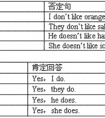Try ____ too much salt oil. [ ]A. not to eat, andB. to not eat, orC. not to eat, or-九年级英语
题文
| Try ____ too much salt oil. |
| [ ] |
| A. not to eat, and B. to not eat, or C. not to eat, or |
答案
| C |
据专家权威分析,试题“Try ____ too much salt oil. [ ]A. not to eat, andB. to no..”主要考查你对 不定式,并列连词 等考点的理解。关于这些考点的“档案”如下:
不定式并列连词
考点名称:不定式
- 动词不定式:
指由to加上动词原形(而且只能是动词原形)所构成的一种非限定性动词,但在有些情况下to可以省略。
动词不定式在语法功能上可作主语、宾语、宾语补足语、表语、定语和状语。 - 动词不定式可以作以上各种成分,但它毕竟是动词,所以有动词的属性。
动词不定式及其短语还可以有自己的宾语、状语,虽然动词不定式在语法上没有表面上的直接主语,但它表达的意义是动作,这一动作一定由使动者发出。
这一使动者我们称之为逻辑主语,其形式如下:
时态 主动形式 被动形式 一般式 (not) to do (not) to be done 完成式 (not) to have done (not) to have been done 进行式 (not) to be doing 完成进行式 (not) to have been doing - 不定式的用法:
1、不定式作主语
例如:To remember this is very important.
注意:为了避免头重脚轻,在许多情况下,通常都将作主语的不定式置于句子后部,而在句首主语位置使用形式主语it。
例如:It is very important to remember this.
2、不定式作表语
例如:He seems to be ill.
注意:不定式作表语主要有三种情况,一是用于seem, appear, prove等系动词之后的不 定式(尤其是to be),
二是像My job is to sweep the floor. 这样的主语与表语“等价”的情形,
三是表示想法、约定、义务、命令、可能性、命运等,如:
You are to come when I call.
3、不定式作宾语
例如:I can not afford to buy a car.
注意:
①不定式不仅用作动词的宾语,还可用作个别介词(but, except)的宾语。
例如:I had no choice but to wait.
②当作宾语的不定式后跟有宾语补足语时,通常要用形式宾语it代替不定式,并将真正的宾语不定式置于宾语补足语之后
例如:I find it difficult to learn Japanese well.
4、不定式作宾语补足语
例如:Who taught you to drive?
5、不定式作定语
例如:I have a question to ask you.
注意:有的名词(如way, chance, right等)后用作不定式可换成of doing sth.
如:It is the best way to do (of doing) it.
但是以下名词后接不定式作定语时通常不能换成of doing sth.
attempt courage decision effort fortune failure invitation wish
6、不定式作状语
例如:I went to France to learn French.
考点名称:并列连词
- 并列连词:
主要是用来表示并列关系、选择关系、因果推理关系等。也可用来连接平行的词,词组或分句。 并列连词表示关系及代表实例:
1.表示并列关系
表示并列关系的连词主要含有“和”、“补充”、“增加”等意思。用来表达并列关系的连词有如下几个:
and 和 both...and...二者都
either...or...或者...或者...
neither...nor...既不...也不...
as well as 也、连同
not only...but (also)... 不但...而且...
e.g.
I used to live in Paris and London.
我过去住在伦敦和巴黎。
Both Jane and Jim are interested in pop music.
詹妮和吉姆对流行音乐都很感兴趣。
She is not only kind but also honest.
她不但和蔼而且诚实。
Bob as well as his parents is going on holiday this summer.
鲍勃和他的父母今年夏天要去度假。
2.表示转折关系
常用来表示转折关系的并列连词有如下几个:
but 但是
yet 然而
still 仍然
while 然而
while 然而、偏偏
e.g.
The winter in Beijing is very cold while that of Kunming is warm.
北京的冬天很冷,然而昆明的冬天却很温暖。
I explained twice, still he counldn't understand.
我解释了两遍,然而他却还不懂。
3.表示选择关系
表示选择关系的并列连词:
or 或者
or else 否则
otherwise 否则
neither...nor... 既不...也不...
either...or... 或者...或者...
e.g.
Would you like leave or would you like to stay?
你是想走还是想留?
You can come either on Saturday or on Sunday.
你可以星期六来也可以星期天来。
Neither you nor I nor anyone else believes such things.
不管你我或者其他任何人都不会相信这件事。
4.表示因果推理关系
表示因果关系的并列连词主要有so,for,then,therefore 等。
e.g.
The air here is polluted, so the crops are dying.
这里的空气受到了污染,所以庄稼快死了。
The leaves of the trees are falling, for it's already autumn.
树叶在落下,因为秋天已经到来了。- 并列连词注意事项:
并列连词for引导的分句只能放在句尾,前面用逗号隔开,表示补充说明的微弱理由,只是为前面的内容提供判断的理由,有时译为并列的某种形式。
这与because不同,because引导的是一种明确的因果关系,解释原因,常可回答why的提问。 - 几个特殊并列连词用法:
一、表示并列关系的and,or,well,as,not only...but also... 等连词也有比较活跃的用法。
and 作为并列连词有多重含义,除了可以表示并列关系外,还可以表示顺承、目的、条件、反复等关系。
e.g:He went to market and bought some vegetables.(表示顺承,动作的先后发生)
他到市场买了一些蔬菜。
Come and help me out.(表示目的)
过来帮我一下。
Be careful and you'll make fewer mistakes.(表示条件)
如果仔细,你所犯的错就少。
二、or 与 either...or...
or表示为“否则”的话,前句一般是祈使句,后句用一般将来时。
在表示选择关系时or 与 either...or... 用法相同,但 either...or...更具强调性。
在多个对象进行选择时,可以用A or B or C... , either A or B or C... , neither A or B or C... 。
e.g:Either Jim or Jake or Jeff knows about this.
三、as well as 与not only... but also...
名词+as well as+名词作主语时,强调前面的名词,谓语动词要根据前面的名词而定。
not only...but also...连接名词作主语时,其强调在后者,谓语动词要根据后面的名词而定。
e.g:China as well as many other countries loves peace.
中国与世界上的其他许多国家一样热爱和平。
Not only Bill but also his parents want to go traveling by bike.
- 最新内容
- 相关内容
- 网友推荐
- 图文推荐
| [家长教育] 孩子为什么会和父母感情疏离? (2019-07-14) |
| [教师分享] 给远方姐姐的一封信 (2018-11-07) |
| [教师分享] 伸缩门 (2018-11-07) |
| [教师分享] 回家乡 (2018-11-07) |
| [教师分享] 是风味也是人间 (2018-11-07) |
| [教师分享] 一句格言的启示 (2018-11-07) |
| [教师分享] 无规矩不成方圆 (2018-11-07) |
| [教师分享] 第十届全国教育名家论坛有感(二) (2018-11-07) |
| [教师分享] 贪玩的小狗 (2018-11-07) |
| [教师分享] 未命名文章 (2018-11-07) |


![Sunday is my birthday. I would like _____ a birthday party, would you _____to my party? [ ]A. have; come B. to have; to come C. have; to come D. to have-七年级英语](http://www.00-edu.com/d/file/ks/4/2/budingshi/2020-01-08/smalla85122db0c71d7fb6ae58187be7f1fd11578430330.png)

![Why areyou here? You are supposed ______ in the classroom now. [ ] A. to studyB. to be studiedC. studying D. to be studying -九年级英语](http://www.00-edu.com/d/file/ks/4/2/budingshi/2020-01-08/small6dee02daa62cac1c71853ac804ab4fbd1578422460.png)
![She is very poor. Little food _____ and no room _____! [ ]A. to eat, to live B. to eat, to live in C. eating, living -八年级英语](http://www.00-edu.com/d/file/ks/4/2/budingshi/2020-01-09/small17b77c2697a3ef8f1461d0d14b016ee51578585185.png)
